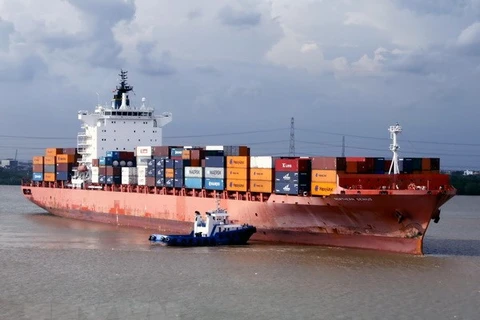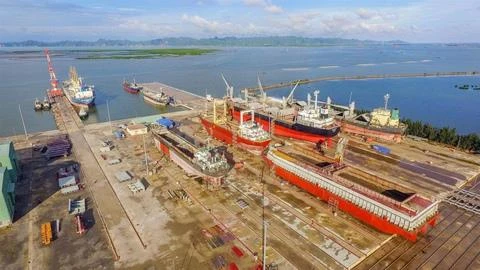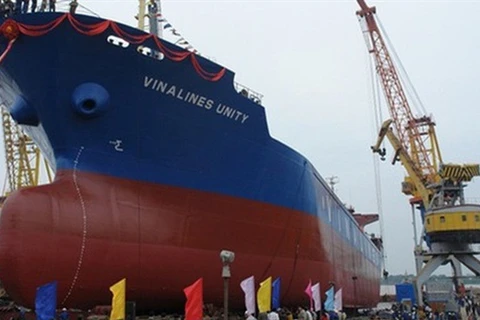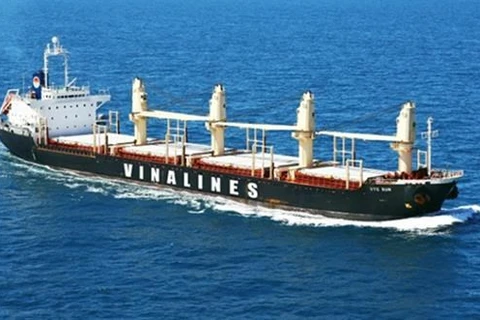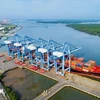Hanoi (VNA) – Modernisation is playing a key role for Vietnam’s shipping industry to dominate the market, experts have said.
According to statistics from the Ministry of Transport, the volume of goods through Vietnam's seaports has maintained stable growth in recent years, expanding by 13.8 percent in the last five years.
Due to the COVID-19 pandemic, the growth in 2020 was just 4 percent, slower than the annual average. Of which, the volume of container cargo through the local seaports in the year was estimated at 22.1 million TEU, up 13 percent compared to 2019.
Deputy Minister of Transport Nguyen Nhat said Vietnam's fleet transport most types of cargo on the domestic sea routes, excluding liquefied petroleum gas (LPG) and bulk cement.
For the type of cargo that the Vietnamese fleet is unable to transport, the ministry has licensed ships carrying foreign flags of Vietnamese enterprises to operate on domestic routes for a short time.
To encourage the development of specialised ships to meet domestic transport demand for LPG, bulk cement and crude oil, he said the ministry had requested enterprises to build or buy ships to replace foreign vessels.
Vietnam would only license foreign-nationality ships until the end of 2023 to operate on domestic routes, he said.
According to the ministry, the percentage of import and export goods transported by local shipping companies halved from 10 percent in 2015 to 5 percent in 2020. That means foreign shipping companies transported 95 percent of Vietnam’s import and export goods.
The foreign shipping companies have 10 different types of fees and surcharges besides costs for freight for Vietnam's import-export goods owners, including container imbalance surcharge, bill fee and lead clamp charge.
In addition, “the shipping companies have continuously increased surcharges and freight rates during the COVID-19 pandemic, leading to higher transportation costs. That has impacted Vietnamese enterprises,” Nhat said.
Financial mechanism needed for promoting shipping industry
According to Nhat, most Vietnamese shipping companies are small-sized businesses and they mainly transport cargo but do not provide logistics services, leading to low efficiency in business activities.
The fleet structure is not developed properly with a large number of ships with small tonnage and lack of ships with large tonnage that could be used on international routes and specialised ships such as ships transporting LPG, chemicals and bulk cement.
Vietnamese enterprises only have ships with a capacity of 1,800 twenty-foot equivalent units (TEUs) while foreign firms have vessels of over 20,000 TEUs.
In addition, Vietnam's seagoing vessel fleet is over 15 years old and many of them use old technology, which is not suitable for transporting import and export goods. They cannot compete with the new generation fleet of foreign enterprises.
An unstable source of cargo means Vietnamese shipping companies have not dared to invest in building new ships.
Nhat stressed that the domestic shipping industry needs support from the State to develop Vietnam’s fleet of cargo ships, according to the Ministry of Transport.
The development of cargo ships is part of the strategy to develop Vietnam's marine economy by 2030.
Therefore, the ministry has proposed the Prime Minister consider and adjust financial mechanisms to support the development of the fleet, including loans with preferential interest rates.
Investment in a fleet of ships requires huge and long-term capital, while local enterprises are unable to invest in high-quality fleets, Nhat noted.
The shipping companies have received very little financial support from the Government in the past few years to carry out fleet development.
Interest rates on bank loans in Vietnam are from 8-10 percent per year, higher than interest rates in other countries such as Japan (1-2 percent), Singapore (3 percent) and China (4.5 percent).
At the same time, when registering a ship to fly the Vietnamese flag, the enterprise must carry out procedures on importing ships and have to pay taxes and fees such as registration fee, value-added tax and import tax on ships. Some ship owners have registered ships with foreign nationality to reduce taxes and fees.
The ministry proposed the Government reduce the corporate income tax for shipping enterprises from 20 percent to 15 percent within three years and personal income tax for seafarers by increasing the threshold of wages that are subject to tax.
To encourage the shipping companies to eliminate old ships with ineffective operations, the ministry has proposed exemption or reduction of taxes and fees, such as registration fees and VAT, when building or buying new and specialised ships suitable for transport needs.
It has also suggested that the State should have coastal fleet management policies to meet the domestic transport demand, promote freight by sea and improve connection among modes of transport./.


